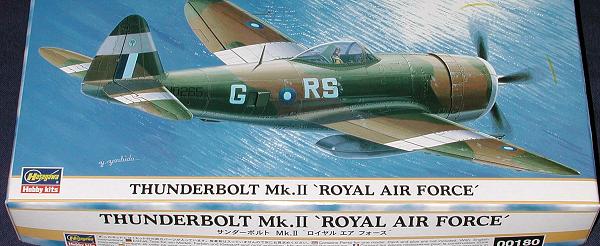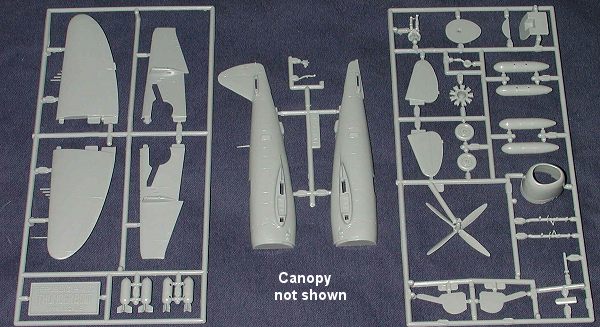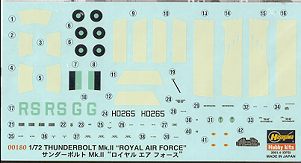
|
KIT: |
Hasegawa 1/72 P-47D Thunderbolt |
|
KIT # |
00180 |
|
PRICE: |
$16.98 |
|
DECALS: |
One aircraft |
|
REVIEWER: |
|
|
NOTES: |
'Royal Air Force' boxing |

|
HISTORY |
Just about every in-service aircraft flown by the US was also flown by RAF squadrons under the Lend-Lease agreement. This includes the P-47 Thunderbolt. However, unlike the Mustang, the P-47 was only used in India/Burma where it was to replace the Hurricane and Mohawk in the ground attack role. The P-47 was particularly suited to this role thanks to its radial engine and prodigious carrying capabilities.
Initial RAF T-bolts in Burma were razorback D-21s (Thunderbolt I) that saw action in the summer of 1944 with 146 squadron and met with great success. During the monsoon season, eight other squadrons were withdrawn back to India and converted to the Thunderbolt, some of them getting the bubble top versions (Thunderbolt II). By the end of the war, there were fifteen Thunderbolt squadrons in the Far East.
Pilots were initially put off by the size of the plane. They'd wanted Spitfires. A number of pilots were killed in training as they were unused to the plane's high speed diving abilities and failed to pull out of dives. A few US pilots were then sent to the various units to show off the plane's capabilities and to help with the conversion process.
RAF T-bolts were initially escorted by Mosquitos but even fully loaded, the P-47 was able to outpace the Mosquitos. The pilots by then realized that they had themselves a real winning plane and escorted missions became a thing of the past. The ruggedness of the P-47 brought back many a pilot and their fondness for the plane grew with each mission.
On occasion, the Thunderbolt pilots were called upon to escort Liberator formations as they headed out to bomb Japanese targets. However they never got to meet large numbers of Japanese planes and so very few RAF Thunderbolt pilots were able to get any air to air victories. Those they did meet were usually not the best as all of the higher performance aircraft were, by this time, being kept in the home islands for use against B-29 and carrier attacks.
|
THE KIT |

One of the first kits by Hasegawa to embrace the engraved panel line revolution of the early 1980s, the P-47 kit has held up rather well. Typical of what you find even today on Hasegawa 1/72 kits, there are decals for the instrument panel and not much else in the way of detailing for the cockpit section. Sure, there is a seat and instrument panel, that that is about it. It is very much a transition kit and even includes a small plastic placard that were found in all the older kits.
The gear doors are not separate and need to be cut . There is no real wheel well
detail either, aside from a retraction strut molded into the inside of the upper
wing. The kit comes with a pair of bombs for the molded in wing racks, or you
can use the cylindrical 'paper' drop tanks that were used in Europe. I don't
think they would be applicable to the RAF version, but I could be mistaken. One
thing that has finally been fixed on this kit are the large sink marks that were
prevalent on the upper wing just forward of the flaps. You can see on the
kit that some sort of work was done to the mold to make these go away. Also
 gone
are the sink marks that were usually on the upper wing opposite the wheel well
'detail'. It is about time and I'm very glad to see it. Perhaps that is what
caused the price to skyrocket as this kit used to retail for well under $5.00.
gone
are the sink marks that were usually on the upper wing opposite the wheel well
'detail'. It is about time and I'm very glad to see it. Perhaps that is what
caused the price to skyrocket as this kit used to retail for well under $5.00.
Instructions are basically the same as they have been for a long time. Only in the bag with the canopy (still a single piece) and new decals is there an additional sheet showing the painting and decal placement for this version. While the decals include the white bands, the white is more of an ivory color that is so typical of Hasegawa decals. Markings are for 30 Sq in India; late 1944.
|
CONCLUSIONS |
Should you have built this kit nearly 20 years ago, you would find absolutely no difference. It really needs a decent interior and fortunately, True Details set 72457 is made for this kit. Even without any aftermarket stuff, this is a super little kit and one that you should consider. However, you may want to look for an older boxing at a swap meet. Though you may have to fill the sink marks, it will be a LOT cheaper!
If you would like your product reviewed fairly and quickly where it will be seen by well over 150,000 visitors a month, please contact me or see other details in the Note to Contributors.